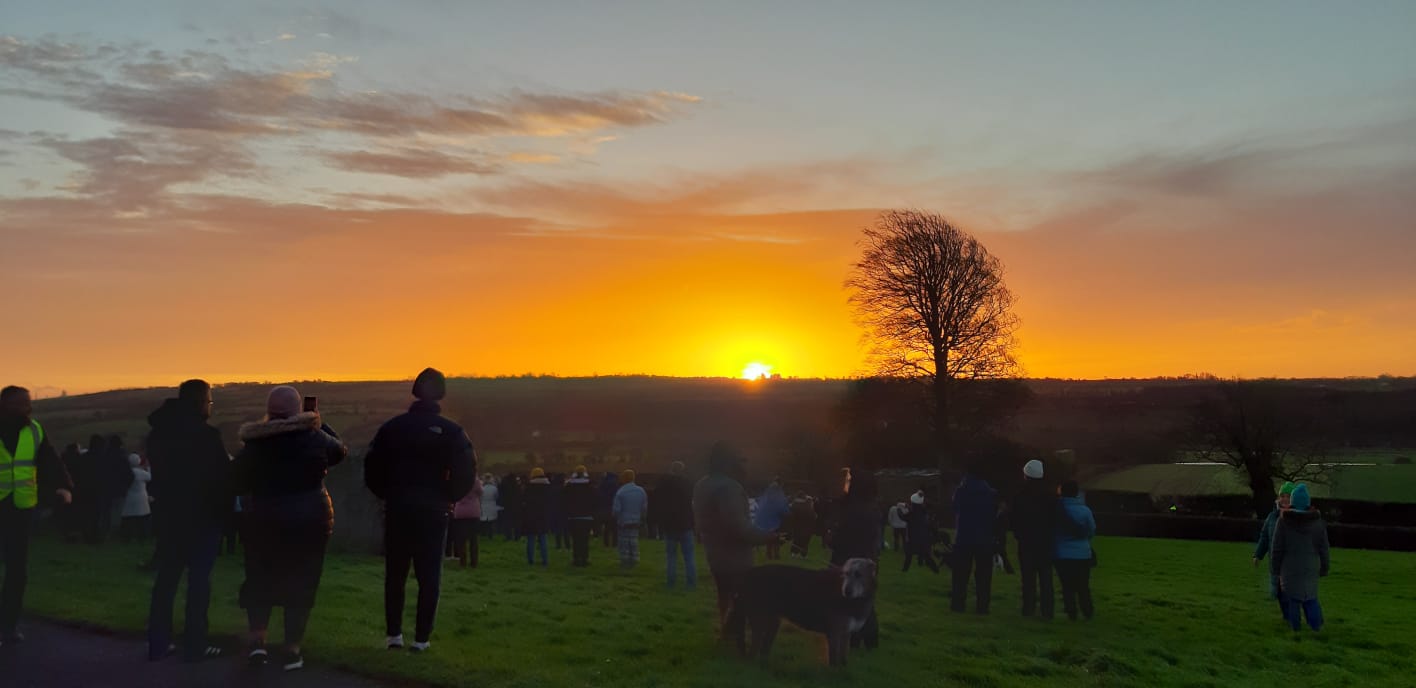Dawn light began stealing
Through the cold universe to County Meath,Over weirs where the Boyne water, fulgent, darkling,
Turns its thick axle, over rick-sized stones
Millennia deep in their own unmovingAnd unmoved alignment.
(from A Dream of Solstice by Seamus Heaney)
From the Latin, solstitium, the apparent standing still of the sun, the Winter Solstice is a turning point. The day after my daughter’s birthday, it is a lovely mid-winter reminder – a reassurance – that the light will come. Marked by ancient rituals that help us keep the faith and not necessarily in a god or in any religious doctrine, the Solstice is a reminder that something good is coming.

In the Mexican village that I call home, such rituals abound, the legacy of pre-Columbian civilizations accessible to everyone in a ceremony on the waterfront almost daily – La Danza de los Voladores. Its origins are attributed to the Totonacapan region of Veracruz, which in 2009 boasted 38 of the 56 volador poles officially recorded in Mexico. First written about in 1612 by Franciscan chronicler, Fray Jaun de Torquemadam, the ritual is a powerful testimony to the tenacity of indigenous groups in adapting their customs and practices to the new order imposed by the Spanish and also in ensuring they live on from one generation to the next.
A handful of onlookers on the Ajijic malecon pause for a moment to watch, smart phones at the ready. In dazzling red and white costumes – the red signifying the heart of the sun – the bird-men are like birds. Circles and flowers embroidered on their clothing are like feathers; tiny mirrors sewn in the fabric catch the sunlight. They begin a solemn procession to the 99ft high pole between two trees, and one by one, four of them climb to its summit, where they will each be closer to the sun god, each of them representing the cardinal points as well as the elements.
A haunting melody slips into the air when a fifth, the caporal, hoists himself up on a tiny wooden platform, the tecomate, at the top. Bending, balancing, hopping from one foot to the other, he plays his flute and beats on a tiny drum, turning to face north, south, east, and west, following the rotation of the earth. The pole below him sways precariously in the breeze but there are no ropes supporting him, no harness, to safety net to catch him. One slip, and he falls to his death.
Up there, the other bird-men sit around him, waiting. Then the dance begins. Headfirst, they hurl themselves into the sky their arms outstretched like wings as they allow the thin ropes tying them to the platform to unravel. Spinning in ever-widening circles around the pole, streamers the color of the rainbow trailing behind them, their descent is majestic. On their way back to earth, they will spiral thirteen times to reflect the fifty-two years in the Aztec calendar – imploring the gods to return the sun to us.
Legend has it that if they land on their feet, they will have pleased the Mayan gods and we will be rewarded with longer days. Confident, they perform a final flourish – a somersault – before returning to us as mere mortals again. The land softly to quiet ‘bravos‘ from spectators who know they have witnessed something sacred, something from another time, for all time.
Far from Lake Chapala, in a massive neolithic tomb in Newgrange, Ireland, the Winter Solstice is being celebrated this morning. It is the first time visitors have been allowed into the chamber since 2019. It is also live-streamed – as it has been since COVID restrictions – enabling anyone with an internet connection, from Meath to Mexico to observe the Solstice phenomenon in a place older even than Stonehenge and the Pyramids.
In the roof of the chamber inside Newgrange is a little opening aligned to the ascending sun. When that single sunbeam shoots through the roof-box at around 9AM, it illuminates for seventeen minutes the burial chamber below, highlighting the geometric shapes carved in the ancient walls.
It is a magic time, long before clocks and calendars and compasses measured time and the distance between us, signifying the turn towards a new year. It is a time when the ancients speak to us, reassuring us that no matter how dark the days, the cycle begins again.
An annual lottery determines who may enters to experience the Solstice phenomenon the way its ancient architects intended, the Stone Age farmers who created it some 5,000 years ago. This year, 12 lucky applicants from as far away as the United States, were selected to experience the spectacle of solstice at Newgrange – sun-worshippers and archeologists, ethnographers and tourists, and regular folks like you and me. Unfortunately, Irish weather provides no guarantee of sunlight, its cloudy skies often keeping the light out, but this morning, the sun obliged to make a brief appearance, offering just enough light to illuminate the tomb.

Photograph: Cyril Byrne
Maybe it’s an act of faith that brings us together to celebrate an ancient light show in an Irish tomb in Ireland or a sky dance above a pueblo mágico in Mexico. Together, on sacred ground, we are connected to both the past and the future. These darkest days of a December offer an opportunity to pause – along with dormant plants and hibernating animals and the rest of nature – to embrace the dark. Even the birds are a little quieter this morning. They know too that brighter days are coming.
“The long night is over. Let’s look forward now to brighter days and all good things to come,” last year’s livestream host whispered to millions watching as sunlight flooded the ancient chamber.


